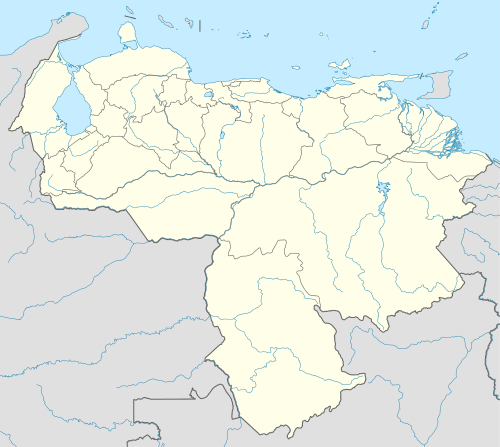San Tomé, Venezuela
San Tomé is an industrial town located about 14 kilometres (9 mi) northeast of the city of El Tigre, in the state of Anzoátegui in Venezuela. It is located near the right bank of the Orinoco River, about 90 leagues from its confluence with the sea, opposite the city of San José de Guanipa and is also known as San Tomede Angostura.
Geography
San Tome consists of two main areas. Campo Norte contains the headquarters of Petróleos de Venezuela, Sociedad Anónima (PDVSA), the country's state-owned oil and natural gas company. Campo Maraven is located here,[1] as well as homes for company employees. Campo Sur is a recreational area and includes workers' residences. It is served by San Tomé Airport (also known as Don Edmundo Barrios Airport)[2] which connects the cities of El Tigre, San José de Guanipa, and San Tomé to the rest of the country. San Tome-Puerto la Cruz highway passes through the town.[3] Industrial Hospital of San Tomé is also located here. There is a golf course in the northern outskirts, known as Campo de Golf San Tomé. It has a very mild temperature, and rarely exceeds 24°C.[4]
History
The town was founded in 1586 by Don Antonio de Berrío on the right bank of the Orinoco River. He was troubled by conflicts with ethnic Indians and hence could not make it his base. The town has a turbulent history, invaded by the English, Dutch, French and the Spanish; it has witnessed colonial atrocities and looting. In 1786 the town was shifted away from the sea by about 90 leagues from the mouth of the Orinico River and since then the town has been called San Tome de Angostura.[4] During the Spanish domination, San Tomé was the residence of numerous official in political, religious and military affairs (the Governor, bishop and character) but was one of the poorest ecclesiastical areas in Latin America.[4] In 1807, it had a population of about 8500, out of which some 300 were black slaves.[4] Today, the town is a thriving business centre because of the PDVSA.
Oil
The area was known as the "Orinoco Heavy Oil Belt" and which was also named "Venezuela's Black ace-in-the hole". The concessions for the Gulf Oil Company were obtained by Addison M. Mcay of the Sun Oil Company. Gene Brossard founded the town. Gustavo A San Roan was the contractor who built it. Henri Pittier, from Switzerland, a botanist, an engineer and also a teacher was responsible for bringing in trees and planting them in the town.[5] The Mene Grande Oil Company was the subsidiary of Gulf Oil Corporation and had their main camp here.[6] Hollis Dow Hedberg, the well known geologist and petroleum scientist, served as the Chief Geologist of Gulf Oil Company.[3] As the industrial site is located within barbed wire fencing, which created a constricted atmosphere, the camp residents nicknamed the camp "Santomaniacs".[7] On 18 September 2006 an oil drill was inaugurated in San Tome by Venezuela's President Hugo Chávez and Iran's President Mahmoud Ahmadinejadto.[8]
Transportation
That place is served by both airports:
- San Tomé Airport (IATA: SOM, ICAO: SVST)
- El Tigre Airport (IATA: ELX)
References
 This article incorporates text from a work in the public domain: Jean-J. Dauxion Lavaysse's A statistical, commercial, and political description of Venezuela, Trinidad, Margarita, and Tobago (1820)
This article incorporates text from a work in the public domain: Jean-J. Dauxion Lavaysse's A statistical, commercial, and political description of Venezuela, Trinidad, Margarita, and Tobago (1820)
- ↑ "Alimentos y Bebidas Region Sur". Universidad Nueva Esparta.
- ↑ "SVST Airport information". DAFIF. Retrieved 8 June 2013.
- 1 2 "Hollis Dow Hedberg (1903-1988)" (pdf). National Academy of Sciences Organization. Retrieved 9 June 2013.
- 1 2 3 4 Lavaysse, Jean-J. Dauxion (1820). A statistical, commercial, and political description of Venezuela, Trinidad, Margarita, and Tobago. G. and W.B. Whittaker. p. 128.
- ↑ E. B. Brossard (June 1993). Petroleum research and Venezuela's INTEVEP: the clash of the giants. PennWell Books/INTEVEP. ISBN 978-0-87814-399-3.
- ↑ Biographical Memoirs. National Academies. 1877. pp. 215–. NAP:12174.
- ↑ Miguel Tinker Salas (2009). The Enduring Legacy: Oil, Culture, and Society in Venezuela. Duke University Press. pp. 161–. ISBN 978-0-8223-9223-1.
- ↑ "Chavez death brings uncertainty, hope to oil patch". The Big Story.com. Retrieved 9 June 2013.
